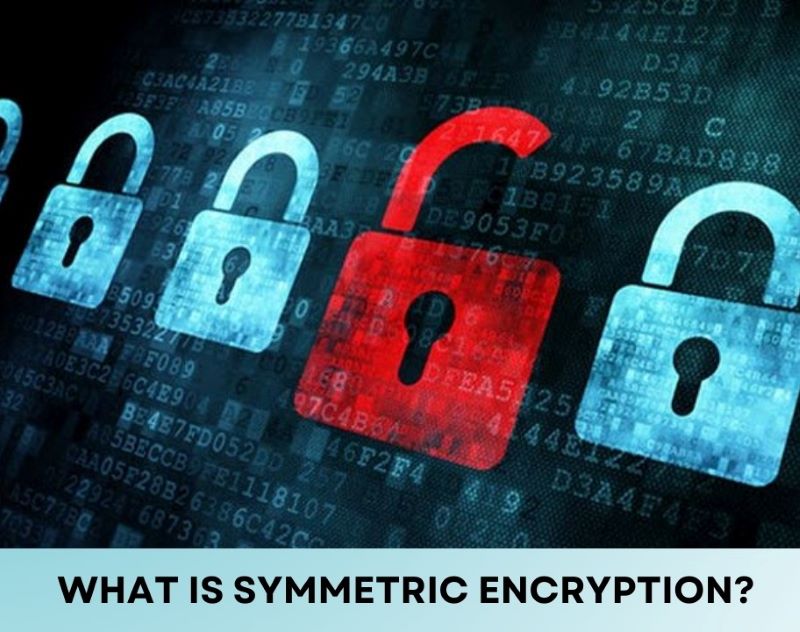
What is Symmetric Encryption? Decrypting data protection secrets
In the digital age, where personal information and business data hold immense value, security becomes an imperative. Hackers are constantly lurking, seeking opportunities to infiltrate and steal critical information. How can we safeguard our digital secrets? The answer lies in a core technology: symmetric encryption. So what is symmetric encryption? Let’s find out in this article.
What is Symmetric Encryption?
What is symmetric encryption? Symmetric encryption is a method of encryption that uses the same secret “key” to transform original information (plaintext) into an unreadable form (ciphertext) and vice versa. Only those possessing the same key can decrypt and access the original information.
Imagine you have a secret box and only those with the key can open it. Symmetric encryption operates in a similar fashion, creating a robust layer of protection for your data.
The mechanism of Symmetric Encryption
Symmetric encryption, with its simple yet effective nature, has become an indispensable tool in safeguarding sensitive information. Let’s explore its mechanism in depth, from the encryption and decryption process to the distinctions between different types of ciphers to fully understand what is symmetric encryption.
Encryption and decryption process
Encryption
- Plaintext: This is the original data you want to protect, which could be text, images, audio, or any other type of data.
- Secret key: This is a random sequence of characters or bits, acting as the “key” to unlock the encrypted information.
- Encryption algorithm: This is a complex mathematical formula that performs transformations on the plaintext and the key to generate the ciphertext.
- Ciphertext: This is the result of the encryption process, a jumbled sequence of characters or bits that is unreadable without the secret key.
Decryption
- Ciphertext: This is the encrypted data you want to decrypt to access the original information.
- Secret key: This is the same key used during the encryption process.
- Decryption algorithm: This is the reverse of the encryption algorithm, performing inverse transformations to recover the original information from the ciphertext.
- Plaintext: This is the original data that has been recovered from the ciphertext.
Comparing Block Ciphers and Stream Ciphers
To grasp the essence of what is symmetric encryption, it’s crucial to understand its different types. Let’s compare two primary types:
Block Cipher
- Divides data into fixed-size blocks (typically 64 or 128 bits).
- Encrypts each block independently using the key and algorithm.
- Advantages: Easy to implement and manage, suitable for encrypting stored data.
- Disadvantages: Can be vulnerable to attacks if the same key is used to encrypt multiple blocks of data.
Stream Cipher
- Encrypts data bit by bit, creating a continuous stream of ciphertext.
- Uses a key and an initialization vector (IV) to generate a pseudo-random keystream.
- This keystream is combined with the plaintext to create the ciphertext.
- Advantages: Fast, suitable for encrypting real-time communication data.
- Disadvantages: Requires careful management of the IV to avoid security vulnerabilities.
Common Symmetric Encryption algorithms
- AES (Advanced Encryption Standard): This is the most widely used encryption standard today, offering key lengths of 128, 192, and 256 bits. AES is highly regarded for its robust security, efficiency, and flexibility for implementation across various platforms.
- DES (Data Encryption Standard): An older encryption standard that was once prevalent but is now discouraged due to its security limitations.
- 3DES (Triple DES): An enhanced version of DES, applying DES encryption three times to bolster security. However, 3DES remains slower than AES and is no longer considered a modern security standard.
- Blowfish, Twofish: These are additional block cipher algorithms that find use in some applications but are not as widespread as AES.
Outstanding advantages of Symmetric Encryption
Understanding the strengths of symmetric encryption is key to appreciating what is symmetric encryption. Here are some of its notable advantages:
- Speed: Symmetric encryption and decryption are very fast, making them suitable for handling large amounts of data.
- Efficiency: Symmetric algorithms require fewer computational resources than asymmetric encryption, saving energy and time.
- Simplicity: Implementing and using symmetric encryption is relatively easy and doesn’t require in-depth knowledge of cryptography.

Challenges to overcome
While symmetric encryption offers numerous benefits, it also presents certain challenges:
- Key Management: Protecting and distributing the secret key is a major challenge. If the key is compromised, all encrypted information is at risk.
- Scalability: As the number of users and devices increases, managing and sharing keys becomes more complex.
Diverse real-world applications
Symmetric encryption finds widespread use in various fields, showcasing the versatility of what is symmetric encryption:
- Securing stored data: Encrypting hard drives, USBs, and cloud data to prevent unauthorized access.
- Securing communication: Encrypting emails, messages, and VPNs to ensure privacy and security during data transmission.
- HTTPS protocol: Encrypting data exchanged between browsers and web servers, protecting personal information and online transactions.
The combination of Symmetric and Asymmetric Encryption
While each encryption method has its own merits, the combination of symmetric and asymmetric encryption creates a robust security framework.
- The problem with Symmetric Encryption: Securely sharing the secret key is a challenge.
- Asymmetric Encryption to the rescue: Asymmetric encryption uses a pair of keys (public and private) to facilitate secure key exchange.
- The perfect combination: Asymmetric encryption is used for secure key exchange, while symmetric encryption handles efficient data encryption and decryption.
What is symmetric encryption? It is a fundamental tool for protecting sensitive information in the digital world. With its speed, efficiency and ease of implementation, it plays a vital role in various security applications. However, key management and addressing new threats remain ongoing challenges.
In the fight against hackers and data protection, symmetric encryption is a powerful weapon we cannot ignore. Stay updated with knowledge and implement the best security practices to ensure the safety of your information.
Solution Of Blockchain hopes this article has provided a comprehensive answer to the question “what is symmetric encryption”.





